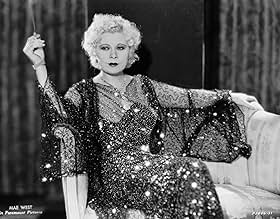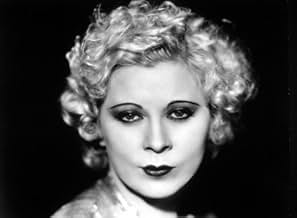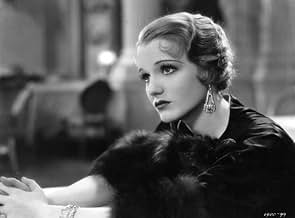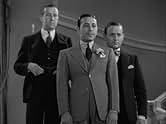NOTE IMDb
6,7/10
1,3 k
MA NOTE
Ajouter une intrigue dans votre langueA successful ex-boxer opens a high-class speakeasy in what once was the childhood home of a formerly rich society girl.A successful ex-boxer opens a high-class speakeasy in what once was the childhood home of a formerly rich society girl.A successful ex-boxer opens a high-class speakeasy in what once was the childhood home of a formerly rich society girl.
- Réalisation
- Scénario
- Casting principal
- Récompenses
- 2 victoires au total
George Templeton
- Patsy
- (as Dink Templeton)
Jay Eaton
- Nightclub Patron
- (non crédité)
Bill Elliott
- Escort
- (non crédité)
Patricia Farley
- Hatcheck Girl
- (non crédité)
Dick Gordon
- Nightclub Patron
- (non crédité)
Theresa Harris
- Ladies' Room Attendant
- (non crédité)
Avis à la une
"Night After Night" was an otherwise unmemorable George Raft opus of the early 1930's... The scene was the entrance to a nightspot...
Enter Mae West, magnificently dripping in so much jewelery it must have given the lighting cameraman several heart attacks in his attempts to "damp it down" so that it didn't "flash up the bottle" as she moved
Cries the hat-check girl: "Goodness, what beautiful diamonds!"
Mae West: "Goodness had nothing to do with it, dearie."
Gangsters' molls... they are part of the legend of the mobster movie And in "Night After Night" it was never openly established just what kind of a dame Mae West was playing, but with all those rocks she looked like the gangster's moll to top them all
Enter Mae West, magnificently dripping in so much jewelery it must have given the lighting cameraman several heart attacks in his attempts to "damp it down" so that it didn't "flash up the bottle" as she moved
Cries the hat-check girl: "Goodness, what beautiful diamonds!"
Mae West: "Goodness had nothing to do with it, dearie."
Gangsters' molls... they are part of the legend of the mobster movie And in "Night After Night" it was never openly established just what kind of a dame Mae West was playing, but with all those rocks she looked like the gangster's moll to top them all
In particular this is a great showcase for George Raft in his first leading role and Mae West in her first film role. Raft plays Joe Anton, a bootlegger who buys a mansion at a foreclosure auction and turns it into a speakeasy. Anton wants what he thinks the Park Avenue crowd has now that he has the money - class. He employs Mabel Jellyman (Alison Skipworth) to tutor him properly in elocution and current events. But Anton has other troubles with his current life as a gangster besides not knowing what fork to use. Rival gangsters are demanding that he sell out to them or they will rub him out. He has two old girlfriends that keep showing up unannounced too - Maudie (Mae West) is easy going about things, but Iris (Wynne Gibson) is demanding to the point of being violent that their old relationship continue. Matters get really complicated when "a real lady" shows up alone night after night at Joe's speakeasy. She's not looking for a pickup, in fact she shuns advances of any kind. It turns out she's the destitute ex-resident of Joe's mansion who misses her old house and her old life.
If you're looking for a really clever tight script, that doesn't seem to be the purpose of this film. It's just one of Paramount's sophisticated pre-codes with lots of little scenes that make the whole thing worthwhile. The scene with a hung-over Alison Skipworth getting a job offer from Mae West with Skipworth trying to tactfully figure out exactly what business Mae is in is priceless - Skipworth can't help but notice that Maudie (Mae West) is covered in diamonds with no visible means of support. There's been lots of speculation about the nature of the relationship between Joe and his man Friday Leo (Roscoe Karnes) given the rather revealing bath scene the two men are in, but I think that was just an opportunity for a little precode male beefcake.
Highly recommended as one of a very few of the Paramount precodes actually on DVD.
If you're looking for a really clever tight script, that doesn't seem to be the purpose of this film. It's just one of Paramount's sophisticated pre-codes with lots of little scenes that make the whole thing worthwhile. The scene with a hung-over Alison Skipworth getting a job offer from Mae West with Skipworth trying to tactfully figure out exactly what business Mae is in is priceless - Skipworth can't help but notice that Maudie (Mae West) is covered in diamonds with no visible means of support. There's been lots of speculation about the nature of the relationship between Joe and his man Friday Leo (Roscoe Karnes) given the rather revealing bath scene the two men are in, but I think that was just an opportunity for a little precode male beefcake.
Highly recommended as one of a very few of the Paramount precodes actually on DVD.
Although this film is will always be remembered for introducing Mae West to cinema audiences it is actually a starring vehicle for George Raft. He had made quite an impact in 'Scarface' and here he is top billed for the first time. The studio really wanted him to be a 'Valentino' type and he certainly looks the part in this film. He's the snappiest dresser you ever did see and there's a lot of heavy makeup on his face to accentuate his smouldering good looks. He even gets to take a bath and it's quite obvious he's naked for the scene - it's all geared up to make the ladies in the audience come over all unnecessary! Unfortunately for George he suggested Mae West for a small role in the film and when she appears she hits it like a whirlwind. It's a pretty slow movie and when Mae arrives she knocks it for six with her quick-fire delivery and outrageous behaviour. She may be fat and nearly forty but she is a wow and for those people who suggest she may have been a man in drag just take a look at her in her negligee and you'll see it's quite clear she's all woman!There's not much in the way of a plot, the art direction is nothing to write home about and there's nothing innovative in the way of camera work but it's worth watching to see these two sexy, classic stars make their mark in Hollywood history. If you want to see how they ended up then you should watch 'Sextette' made forty six years later but I don't think I'd recommend it! Enjoy them in their prime!
I was expecting a lousy film whose only value was as the debut film of Mae West - I mean Leonard calls it a "crashing bore"! But what I got was a delightful film, excellently acted by all, with a profound theme and great dialogue. It is a film about dissatisfaction - all the characters are unhappy with their lot and desperately grasping for change. George Raft, the slick gangster, wants an education and true love. Constance Cummings also wants true love, although she thinks she wants security. And Alison Skipworth wants the wild life instead of school teacher drudgery. Only Mae West seems happy with her place as a man-devouring cosmetician.
This film is not a comedy - although it has many hilarious scenes (wait until you see West and Skipworth in bed together!). It is a frank and insightful drama, very risque and dangerously sexual. George Raft is unusually sensitive, Constance Cummings outstanding and Alison Skipworth dazzling. The supporting cast is also fine - led by the incomparable Mae West. A rare treat from the early 1930's.
This film is not a comedy - although it has many hilarious scenes (wait until you see West and Skipworth in bed together!). It is a frank and insightful drama, very risque and dangerously sexual. George Raft is unusually sensitive, Constance Cummings outstanding and Alison Skipworth dazzling. The supporting cast is also fine - led by the incomparable Mae West. A rare treat from the early 1930's.
While I enjoyed “The Mae West Glamour Collection” more than I expected to, I decided to leave her debut film for last, knowing that it wouldn’t be a typical vehicle of hers since she wasn’t the lead; I also figured it would be, as Leonard Maltin bluntly puts it, “a crashing bore”. However, I was quite surprised by how engaging and entertaining it all was – if, by no means, a classic. The film, in fact, is an agreeable blend of two styles that were en vogue during the early Talkie era: the sophisticated comedy-drama and the gangster picture, apart from also being adapted from a stage play (as were a good many movies back then).
The lead proper of the film is George Raft, who had just shot to stardom following his memorable supporting role in Howard Hawks’ SCARFACE (1932); of the stars associated with the heyday of the Gangster movie, Raft always seemed to me the most limited in range – but he does well enough here, flanked by his butler-cum-henchman Roscoe Karns (a mainstay of 1930s comedies). Watching this flick 75 years after it was made, I couldn’t help but wonder about all the gay subtexts today’s audiences would erroneously interpret in their “relationship” here!
Raft is the owner of a speakeasy who wants to improve himself for the sake of ‘mysterious’ socialite Constance Cummings (who, as it turns out, used to own the building) – despite being involved with at least two other women of lower standards (Wynne Gibson and Mae West); to do so, he engages the services of elderly teacher Alison Skipworth. Cummings (who’s adorable throughout – as had also been that same year in Harold Lloyd’s MOVIE CRAZY) incurs the wrath of jealous Gibson, who confronts her and Raft with a gun – a situation which Cummings finds exciting, drawing her nearer to Raft than she intended and deluding him into thinking that she has affections for him; of course, when he finds out that she had counted on marrying wealthy Louis Calhern all along, he gives up his cultured airs and withdraws his promise of selling the club to a rival! But during the ensuing mob fracas at Raft’s joint, Cummings realizes that she loves him after all...
As I said, I found the film to be fairly interesting for several reasons: Mae West’s own role isn’t central to the main plot (in fact, she not only appears exactly at the midway point of the film but shares more scenes – and even a bed! – with Skipworth than she does with Raft himself), but her presence certainly boosts proceedings; already, she’s got her way with dialogue (and not just the famous “Goodness had nothing to do with it, dearie” line) but it also feels like she’s playing a real character in this case rather than just being her in-your-face ‘naughty’ self…and West’s figure is perhaps at its sexiest here with as racy a costume as Pre-Code Hollywood liberalism ever got!
It’s amusing to watch the accompanying trailer today – hyping Raft’s rising star power (even mentioning a couple of earlier films apart from SCARFACE, both of which are now completely forgotten), and how this was achieved largely through the clamor of the movie-going public, when NIGHT AFTER NIGHT’s greatest (single?) claim to fame nowadays is for having introduced Mae West to the silver screen!
Finally, I wonder whether Universal is planning to release a second set of her films (they own four of her remaining titles); THE HEAT’S ON (1943) is a Columbia picture but it has already been released by Universal on R2 as part of a 6-Disc Mae West Set which also includes the bulk of the as-yet-unavailable titles on R1 (plus a couple of overlaps)!
The lead proper of the film is George Raft, who had just shot to stardom following his memorable supporting role in Howard Hawks’ SCARFACE (1932); of the stars associated with the heyday of the Gangster movie, Raft always seemed to me the most limited in range – but he does well enough here, flanked by his butler-cum-henchman Roscoe Karns (a mainstay of 1930s comedies). Watching this flick 75 years after it was made, I couldn’t help but wonder about all the gay subtexts today’s audiences would erroneously interpret in their “relationship” here!
Raft is the owner of a speakeasy who wants to improve himself for the sake of ‘mysterious’ socialite Constance Cummings (who, as it turns out, used to own the building) – despite being involved with at least two other women of lower standards (Wynne Gibson and Mae West); to do so, he engages the services of elderly teacher Alison Skipworth. Cummings (who’s adorable throughout – as had also been that same year in Harold Lloyd’s MOVIE CRAZY) incurs the wrath of jealous Gibson, who confronts her and Raft with a gun – a situation which Cummings finds exciting, drawing her nearer to Raft than she intended and deluding him into thinking that she has affections for him; of course, when he finds out that she had counted on marrying wealthy Louis Calhern all along, he gives up his cultured airs and withdraws his promise of selling the club to a rival! But during the ensuing mob fracas at Raft’s joint, Cummings realizes that she loves him after all...
As I said, I found the film to be fairly interesting for several reasons: Mae West’s own role isn’t central to the main plot (in fact, she not only appears exactly at the midway point of the film but shares more scenes – and even a bed! – with Skipworth than she does with Raft himself), but her presence certainly boosts proceedings; already, she’s got her way with dialogue (and not just the famous “Goodness had nothing to do with it, dearie” line) but it also feels like she’s playing a real character in this case rather than just being her in-your-face ‘naughty’ self…and West’s figure is perhaps at its sexiest here with as racy a costume as Pre-Code Hollywood liberalism ever got!
It’s amusing to watch the accompanying trailer today – hyping Raft’s rising star power (even mentioning a couple of earlier films apart from SCARFACE, both of which are now completely forgotten), and how this was achieved largely through the clamor of the movie-going public, when NIGHT AFTER NIGHT’s greatest (single?) claim to fame nowadays is for having introduced Mae West to the silver screen!
Finally, I wonder whether Universal is planning to release a second set of her films (they own four of her remaining titles); THE HEAT’S ON (1943) is a Columbia picture but it has already been released by Universal on R2 as part of a 6-Disc Mae West Set which also includes the bulk of the as-yet-unavailable titles on R1 (plus a couple of overlaps)!
Le saviez-vous
- GaffesA shadow of the boom microphone is visible to the upper left of the front door of the speakeasy when Maudie first arrives.
- Citations
Hatcheck girl: Goodness, what beautiful diamonds!
Maudie: Goodness had nothing to do with it, dearie.
- ConnexionsFeatured in L'univers du rire (1982)
- Bandes originalesEveryone Says I Love You
(uncredited)
Music by Bert Kalmar
Played at the speakeasy when Joe makes the rounds and first spots Jerry
Also played at the end
Meilleurs choix
Connectez-vous pour évaluer et suivre la liste de favoris afin de recevoir des recommandations personnalisées
- How long is Night After Night?Alimenté par Alexa
Détails
- Date de sortie
- Pays d’origine
- Langue
- Aussi connu sous le nom de
- Night After Night
- Lieux de tournage
- Société de production
- Voir plus de crédits d'entreprise sur IMDbPro
- Durée
- 1h 13min(73 min)
- Couleur
- Rapport de forme
- 1.37 : 1
Contribuer à cette page
Suggérer une modification ou ajouter du contenu manquant



































